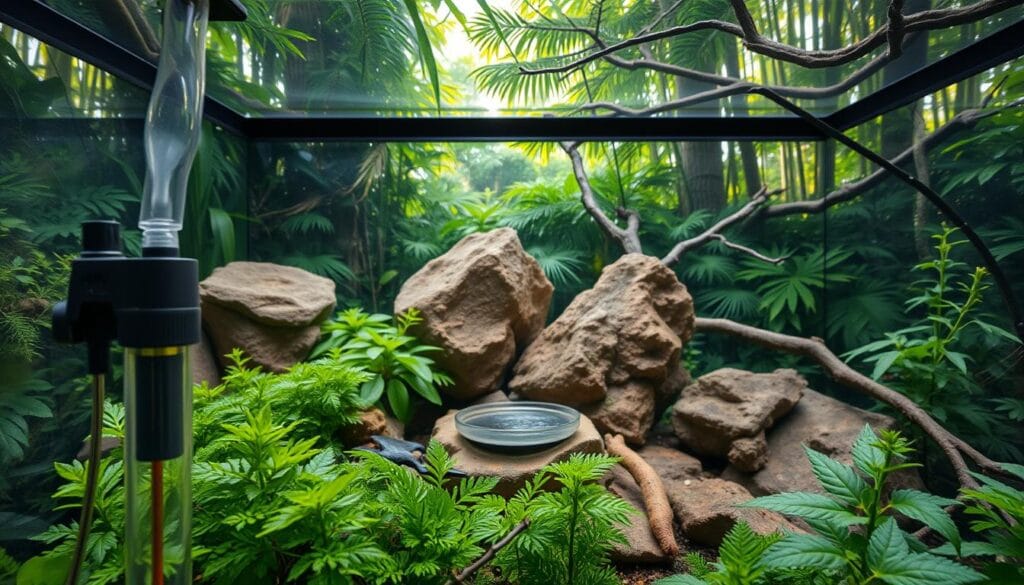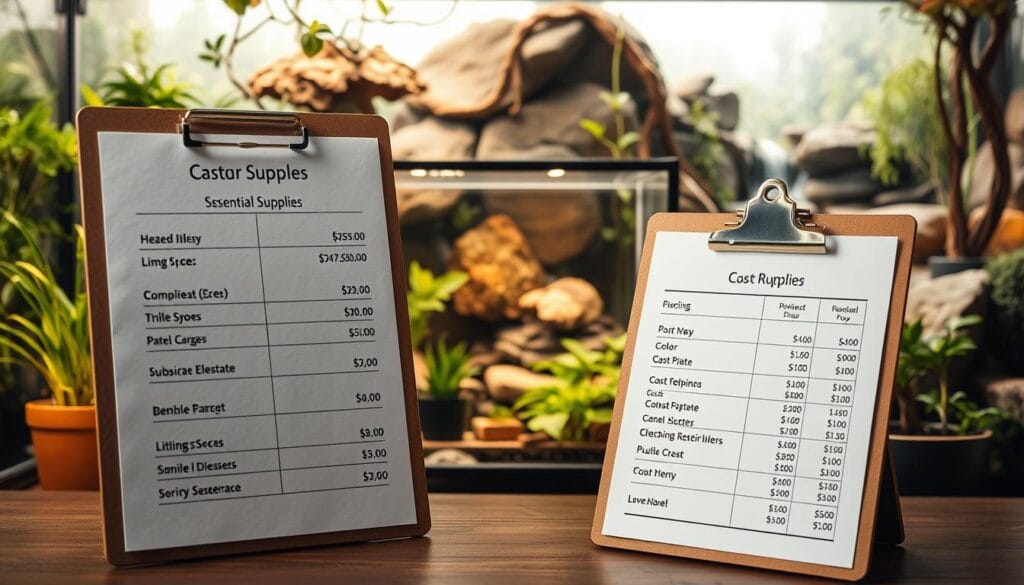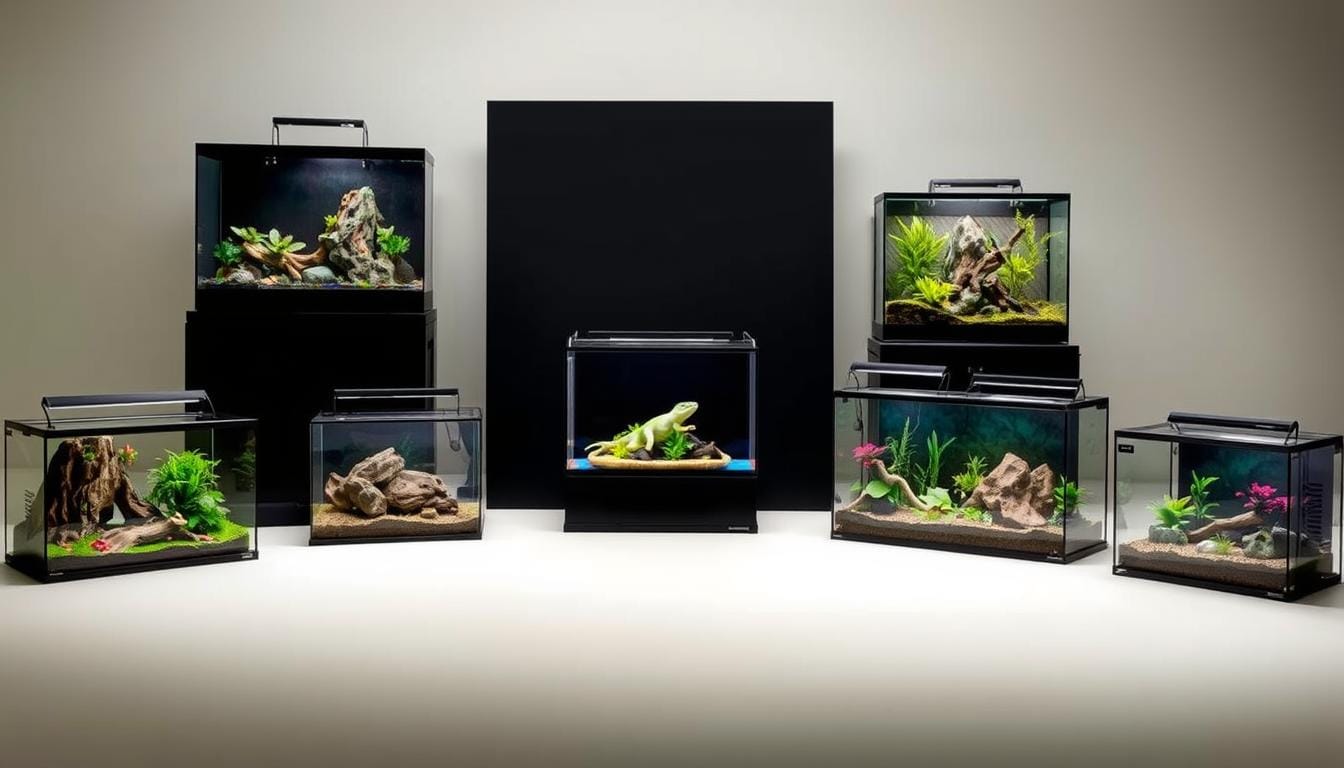Creating the perfect home for your scaly friend is more than just buying an enclosure. Your reptile terrarium is key to your pet’s health and happiness. Choosing the right terrarium means looking at many factors that affect your reptile’s life.
Reptile owners know these pets need special homes. Unlike other pets, reptiles need exact conditions that match their natural habitats. A good reptile terrarium is more than a box. It’s a space made just for your pet’s needs.
Whether you’re new to reptiles or have experience, picking the right terrarium is important. Details like temperature and space are critical for a happy pet. Every part of the terrarium matters for your pet’s well-being.
Table of Contents
Understanding Your Reptile’s Needs
To create the perfect reptile habitat, you need to know what your pet needs. Each reptile species has its own special needs. These needs affect their health, behavior, and happiness. Your reptile’s home must be like their natural environment to help them thrive.
- Bearded dragons need basking temperatures between 95-110°F
- Ball pythons prefer temperature ranges from 78-96°F
- Crested geckos like humidity levels between 60-80%
Habitat Requirements
Knowing your reptile’s natural habitat is key. Reptiles, being ectothermic, need outside heat to stay warm. So, your reptile’s home must have the right temperature and humidity to match their natural home.
“A well-designed habitat is the foundation of reptile health and happiness.” – Reptile Care Experts
Temperature and Humidity Control
Temperature and humidity are vital for reptiles. The wrong levels can cause serious health problems. Use special heaters, UVB lights, and misting systems to keep the environment just right.
Space Considerations
Space needs differ a lot between species. For example:
- Leopard geckos: 10-gallon tank for one adult
- Ball pythons: 40-gallon tank recommended
- Bearded dragons: 75-gallon tank for adult specimens
Do your research to find the best space for your reptile. This will help them live happily and stay healthy for a long time.
Types of Reptile Terrariums
Choosing the right reptile tank is key for your pet’s health and happiness. Different materials have unique benefits for reptile cages. Each one meets specific needs and environments.
Glass Terrariums: Clarity and Visibility
Glass reptile tanks offer clear views and are great for those who love to watch their pets. Brands like Exo Terra have glass terrariums with special features. These include:
- Locking front doors
- Screen tops for ventilation
- Smooth surfaces ideal for climbing
Prices for glass terrariums start at $54.99 for small Nano enclosures. Larger models cost $99.99. The Zoo Med Naturalistic Terrarium and Exo Terra Glass Terrarium both cost $84.99.
Plastic Terrariums: Lightweight and Affordable
Plastic reptile cages are light and easy on the wallet. They come in different sizes. Medium acrylic options are $39.99, and larger ones are $69.99.
Wooden Terrariums: Natural Aesthetics
Wooden reptile tanks have a natural look and keep the environment warm. New Age Pet® offers wooden stands and lounges. Prices range from $154.99 to $448.99, giving you many options for a cozy home.
When picking a reptile tank, think about your pet’s needs and the environment they like.
Size Matters: Choosing the Right Dimensions
Finding the perfect reptile terrarium is key for your pet’s health and happiness. The right size reptile tank is vital. It gives your pet enough room to move, explore, and act naturally.
- Species-specific space requirements
- Your reptile’s current size and future growth
- Natural habitat and behavior patterns
Length, Width, and Height Considerations
Different reptiles need different spaces. Arboreal species like crested geckos need tall tanks for climbing. Terrestrial reptiles need more room to roam on the ground.
Species-Specific Size Guidelines
Here are the minimum enclosure sizes for popular reptile pets:
- Bearded Dragons: 120-gallon enclosure (4x2x2 feet)
- Leopard Geckos: 40-gallon tank (36x18x18 inches)
- Ball Pythons: 4x2x2 feet minimum
- Corn Snakes: 4x2x1 feet enclosure
Pro tip: Always choose a slightly larger reptile terrarium than the minimum recommended size to ensure your pet’s comfort and well-being.
Remember, these are just starting points. Bigger enclosures mean more fun, better temperature control, and more natural behavior. Your reptile will love the extra room to explore and grow.
Essential Features to Consider
Creating the perfect reptile terrarium is all about paying attention to key features. Your reptile’s health and happiness depend on the right accessories and understanding their environment.
Ventilation: Breathing Life into Your Habitat
Good airflow is key for a healthy reptile home. A well-ventilated tank stops stale air, keeps humidity down, and fights off bacteria. Here are some tips for better ventilation:
- Install mesh screens or ventilation panels
- Ensure cross-ventilation with multiple air holes
- Use adjustable vents to control airflow
Lighting Solutions for Optimal Health
Reptiles need special lighting for their health. Each species has its own lighting needs:
| Reptile Type | UVB Requirements | Daily Light Exposure |
|---|---|---|
| Bearded Dragons | 10-12 hours daily | 10.0 UVB bulb recommended |
| Crested Geckos | 6-8 hours daily | 5.0 UVB bulb suggested |
| Ball Pythons | Minimal UVB needed | 12-hour day/night cycle |
Heating Options for Reptile Comfort
Keeping the right temperature is essential for reptile health. Your terrarium should have various heating options:
- Ceramic heat emitters for consistent warmth
- Under-tank heating pads
- Basking lamps for temperature gradients
“Temperature is not just a number—it’s the difference between survival and thriving for reptiles.” – Reptile Care Experts
By choosing and combining these key features, you’ll make a safe and happy home for your reptile.
Setting Up the Terrarium
Creating the perfect habitat for your reptile is all about planning and detail. A well-designed reptile tank setup is more than just a place for your pet. It’s about making a living space that feels like home, supporting their health and happiness.
Choosing the Right Substrate
Choosing the right substrate is key for your reptile’s health and comfort. Each species needs a specific type of substrate to do well. For dry environments, consider these options:
- Arcadia Earth Mix Arid substrate
- ProRep BioLife Desert
- Recommended substrate depth of around 5 cm
Creating Engaging Decor and Hiding Spots
Reptile terrarium accessories are important for a fun environment. Your pet needs places to hide, climb, and explore. Add natural elements like branches, rocks, and live plants to encourage natural behavior.
- Include at least 7 different plant species
- Use cacti and succulents for arid environments
- Create multiple hiding spots
Water Features and Hydration
Keeping your reptile hydrated is vital. Choose water bowls that are the right size and easy to clean. Some reptiles might need extra misting to keep the humidity right.
- Daily spot-cleaning of water dishes
- Maintain humidity between 40-60%
- Use a misting system for consistent moisture
With careful setup and regular care, you’ll make a thriving home for your reptile. They’ll be happy and healthy.
Maintenance Tips for Your Terrarium

Keeping a reptile terrarium healthy needs regular care. It’s not just a place for your pet; it’s a living space that needs constant attention. This ensures your reptile stays healthy and happy.
- Regular cleaning schedules
- Consistent environmental monitoring
- Adapting to your reptile’s changing needs
Cleaning and Sanitizing
Cleaning your terrarium is key to keeping it disease-free. Use safe cleaners and scrub all surfaces well. Clean up waste every day and do a deep clean every 2-4 weeks, based on your reptile’s needs.
Monitoring Conditions
It’s vital to control the environment for your reptile’s health. Use digital tools to check temperature and humidity levels every day.
| Monitoring Tool | Purpose | Recommended Frequency |
|---|---|---|
| Thermometer | Temperature tracking | Daily |
| Hygrometer | Humidity measurement | Daily |
| UVB meter | Light intensity check | Monthly |
Adjusting Setup as Needed
Your reptile’s needs will change with time. Be ready to change the substrate, lighting, and habitat as your pet grows. Being flexible is essential for a thriving terrarium.
By sticking to these care tips, you’ll make a stable, healthy home for your reptile. This will help them thrive for years to come.
Common Mistakes to Avoid
Keeping a reptile cage healthy needs careful attention and knowing your pet’s needs. Many reptile owners make mistakes that harm their pet’s health.
Reptile care is more than just a basic enclosure. Experienced owners know to avoid common mistakes:
- Overcrowding the terrarium with multiple reptiles
- Neglecting proper temperature and humidity controls
- Skipping regular maintenance and cleaning
- Ignoring species-specific environmental requirements
Overcrowding: A Dangerous Mistake
Reptiles can fight over space, leading to health risks. Many new owners don’t realize male reptiles can get aggressive in small spaces. Stress from overcrowding can cause serious health problems.
Temperature and Habitat Challenges
Wrong temperatures can harm your reptile. For example, bearded dragons need specific temperatures:
- Basking area: 105-115°F (40-46°C)
- Cooler side: 70-85°F (21-29°C)
- Humidity levels: 30-40%
Maintenance Matters
Ignoring terrarium upkeep can be dangerous. Proper care includes:
- Weekly habitat cleaning
- Monthly deep sanitization
- Regular equipment checks
- Monitoring environmental conditions
Remember: A well-maintained reptile enclosure is key to your pet’s longevity and health.
Avoiding these mistakes makes a safer, more comfortable home for your reptile.
Budgeting for Your Reptile Terrarium

Creating the perfect reptile tank needs careful financial planning. Knowing the costs helps you make a budget. This way, you can ensure your pet’s comfort without spending too much.
Initial Setup Costs
Setting up a reptile terrarium comes with several expenses. The costs can vary a lot:
- Reptile terrarium: $10 to $130
- Large glassware pieces: $100 to $200
- Fully automated vivarium tanks: Around $400
- Terrarium plants: $5 to $15 each
- Substrate mix: $10 to $20 per bag
“Investing in quality equipment upfront can save you money in the long run.”
Ongoing Maintenance Expenses
Your reptile tank will need ongoing investment. Costs include:
- Electricity for heating and lighting
- Replacement bulbs
- Substrate refreshment
- Food and supplements
- Potential veterinary care
Plan to spend $50-$300 a year on maintenance. Tip: Compare prices, look for sales, and buy in bulk to save money.
Remember, a well-planned reptile terrarium is an investment in your pet’s health and happiness. With careful budgeting, you can provide the best environment for them.
Resources for Further Research
Learning about reptile habitats is a lifelong journey. This guide is just the start. It helps you understand the complex needs of reptiles.
Online platforms are full of knowledge for reptile lovers. Sites like ReptiFiles and The Reptile Database have detailed info on reptile habitats. Forums like Reptile Forums UK and Reddit’s r/reptiles connect you with experts. They share tips on terrarium design and care.
Essential Reference Materials
Specialized reptile care books are a great investment. Experts like Philippe de Vosjoli and Francis Baines share valuable insights. Veterinary clinics for exotic pets also offer advice to improve your terrarium.
Professional Networks
Local herpetological societies and vets are key resources. They help with complex care, health issues, and specific habitat needs. They’re essential for new reptile owners.
FAQ
How do I know which type of terrarium is best for my reptile?
What is the most important factor in setting up a reptile habitat?
How often should I clean my reptile’s terrarium?
What lighting do reptiles need in their terrarium?
How do I create the right temperature gradient in a reptile terrarium?
What substrate is best for my reptile’s terrarium?
How much does a proper reptile terrarium setup cost?
How do I know which type of terrarium is best for my reptile?
What is the most important factor in setting up a reptile habitat?
How often should I clean my reptile’s terrarium?
What lighting do reptiles need in their terrarium?
How do I create the right temperature gradient in a reptile terrarium?
What substrate is best for my reptile’s terrarium?
How much does a proper reptile terrarium setup cost?
FAQ
How do I know which type of terrarium is best for my reptile?
The right terrarium depends on your reptile’s needs. Glass terrariums are good for reptiles that like humidity. PVC enclosures are better for those that need steady temperatures. Think about your reptile’s natural home, size, and needs when picking a terrarium.
What is the most important factor in setting up a reptile habitat?
The key is to make a habitat that feels like home for your reptile. You need the right temperature, humidity, lighting, and space. Learn what your reptile needs to live well.
How often should I clean my reptile’s terrarium?
Clean up daily to remove waste and uneaten food. Deep clean every 4-6 weeks by removing substrate, disinfecting, and replacing decorations. Use safe cleaning products and dry the terrarium before putting your pet back in.
What lighting do reptiles need in their terrarium?
Reptiles need UVB lighting for health. The type and time of lighting vary by species. Diurnal reptiles need 10-12 hours of light, while nocturnal ones need less. Always check the specific lighting needs for your reptile.
How do I create the right temperature gradient in a reptile terrarium?
Use heat lamps, ceramic heat emitters, or under-tank heating pads for a temperature gradient. This lets your reptile move between warm and cool spots. Use a digital thermometer to check the temperature in different areas.
What substrate is best for my reptile’s terrarium?
The best substrate depends on your reptile’s species. Tropical reptiles need moisture-retaining substrates like coconut fiber. Desert species prefer dry materials like sand. Always choose a safe substrate that matches your reptile’s natural habitat.
How much does a proper reptile terrarium setup cost?
Setting up a terrarium can cost between 0 to
FAQ
How do I know which type of terrarium is best for my reptile?
The right terrarium depends on your reptile’s needs. Glass terrariums are good for reptiles that like humidity. PVC enclosures are better for those that need steady temperatures. Think about your reptile’s natural home, size, and needs when picking a terrarium.
What is the most important factor in setting up a reptile habitat?
The key is to make a habitat that feels like home for your reptile. You need the right temperature, humidity, lighting, and space. Learn what your reptile needs to live well.
How often should I clean my reptile’s terrarium?
Clean up daily to remove waste and uneaten food. Deep clean every 4-6 weeks by removing substrate, disinfecting, and replacing decorations. Use safe cleaning products and dry the terrarium before putting your pet back in.
What lighting do reptiles need in their terrarium?
Reptiles need UVB lighting for health. The type and time of lighting vary by species. Diurnal reptiles need 10-12 hours of light, while nocturnal ones need less. Always check the specific lighting needs for your reptile.
How do I create the right temperature gradient in a reptile terrarium?
Use heat lamps, ceramic heat emitters, or under-tank heating pads for a temperature gradient. This lets your reptile move between warm and cool spots. Use a digital thermometer to check the temperature in different areas.
What substrate is best for my reptile’s terrarium?
The best substrate depends on your reptile’s species. Tropical reptiles need moisture-retaining substrates like coconut fiber. Desert species prefer dry materials like sand. Always choose a safe substrate that matches your reptile’s natural habitat.
How much does a proper reptile terrarium setup cost?
Setting up a terrarium can cost between $200 to $1,000. This includes the terrarium, lighting, heating, substrate, decorations, and accessories. Remember to budget for ongoing costs like electricity and replacement bulbs. A good setup is key for your reptile’s health.
Can I keep multiple reptiles in the same terrarium?
It’s not usually a good idea to keep different reptiles together. Each species has its own needs, and sharing can cause stress and aggression. Even the same species may not get along, so it’s best to keep them separate.
How do I prevent my reptile from escaping the terrarium?
Make sure your terrarium has a secure, tight-fitting lid with ventilation. Use locks or clips for active species. Check for gaps or escape routes often. Some reptiles are great at escaping, so a well-sealed terrarium is essential.
What resources can help me learn more about reptile care?
Read reptile care books, join online forums like Reptile Forums UK or Reptile Center, and visit veterinary websites. Attend reptile expos and talk to a vet specializing in exotic pets. These resources can help you learn a lot about reptile care and terrarium management.
,000. This includes the terrarium, lighting, heating, substrate, decorations, and accessories. Remember to budget for ongoing costs like electricity and replacement bulbs. A good setup is key for your reptile’s health.
Can I keep multiple reptiles in the same terrarium?
It’s not usually a good idea to keep different reptiles together. Each species has its own needs, and sharing can cause stress and aggression. Even the same species may not get along, so it’s best to keep them separate.
How do I prevent my reptile from escaping the terrarium?
Make sure your terrarium has a secure, tight-fitting lid with ventilation. Use locks or clips for active species. Check for gaps or escape routes often. Some reptiles are great at escaping, so a well-sealed terrarium is essential.
What resources can help me learn more about reptile care?
Read reptile care books, join online forums like Reptile Forums UK or Reptile Center, and visit veterinary websites. Attend reptile expos and talk to a vet specializing in exotic pets. These resources can help you learn a lot about reptile care and terrarium management.


2 thoughts on “How to Choose the Best Reptile Terrarium for Your Pet”